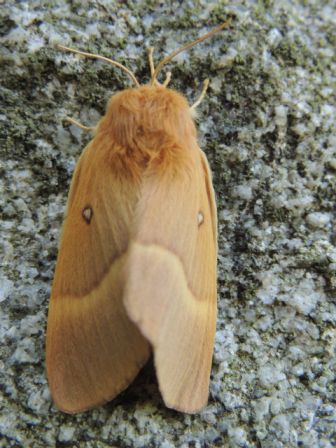Minime à bandes jaunes : Différence entre versions
m (A déprotégé « Minime à bandes jaunes ») |
|||
| (4 révisions intermédiaires par le même utilisateur non affichées) | |||
| Ligne 3 : | Ligne 3 : | ||
[[Image:Minimebandesjaunes.jpg]]<br> | [[Image:Minimebandesjaunes.jpg]]<br> | ||
| − | ''Lasiocampa quercus'' - photo Joëlle Gouin | + | Minime à bandes jaunes ''Lasiocampa quercus'' - photo © Joëlle Gouin |
| − | |||
| − | |||
| − | |||
| − | |||
| − | |||
| + | ====== Etymologie ====== | ||
| + | *'''Nom latin''' : ''Lasiocampa quercus'' | ||
| + | *'''Autre nom''' : Bombyx du chêne. | ||
| + | *'''Nom anglais''' : Oak Eggar. | ||
| + | *'''Famille''' : '''Lasiocampidae''' | ||
====== Description ====== | ====== Description ====== | ||
| − | Mâle brun châtain sombre, orné d'une bande post-médiane jaune d'or, et, aux antérieures, d'un point blanc. | + | *'''Taille''' : 24-31 mm (mâle). |
| − | + | *'''Mâle''': brun châtain sombre, orné d'une bande post-médiane jaune d'or, et, aux antérieures, d'un point blanc. | |
| + | *'''Femelle''': teinte plus jaune, avec la bande plus diffuse. | ||
| + | ====== Plantes hôtes ====== | ||
| + | *'''Chenille''' sur arbres fruitiers, chênes, nombreux arbustes. | ||
====== Répartition ====== | ====== Répartition ====== | ||
| − | + | *'''France''' : partout. | |
| − | + | *'''Europe''' : Europe jusqu'aux Monts Altaï. | |
====== Habitat ====== | ====== Habitat ====== | ||
| − | Plaine | + | *'''Plaine et montagne''', landes, bois clairs, zones marécageuses. |
| − | + | ====== Ecologie ====== | |
| − | ====== | + | *'''Période de vol''' : juin-septembre (1 génération). |
| − | + | *La '''chenille hiverne''' et continue sa maturation au printemps. | |
| − | |||
| − | |||
| − | |||
| − | |||
====== Statut ====== | ====== Statut ====== | ||
| − | + | *Pas de statut de protection connu. | |
| − | |||
====== Bibliographie ====== | ====== Bibliographie ====== | ||
| − | -- | + | *Bebbington John & Lewington Richard (2007) - '''Guide to the hawkmoths of the British Isles'''. Edition Field Studies Council (FSC). |
| + | *Leraut Patrice (2006) - '''Papillons de nuit d'Europe, bombyx, sphinx, écailles...''' VOL I. NAP éditions. | ||
| + | *Leraut Patrice (2009) - '''Papillons de nuit d'Europe, géomètres''' VOL II. NAP éditions. | ||
| + | *Lewington Richard (2006) - '''Guide to the day-flying moths of Britain'''. Edition Field Studies Council (FSC) | ||
| + | *Manley Chris (2008) - '''British moths and butterflies, a photographic guide'''. Edition A & C Black. | ||
| + | *Robineau Roland (2007) -'''Guide des papillons nocturnes de France''', plus de 1620 espèces décrites et illustrées. Edition Delachaux & Niestlé. | ||
| + | *Skinner Bernard (2009) -'''Colour identification guide to moths of the British isles'''. Edition Apollo Books. | ||
| + | *Townsend M. & Waring P. (2007) -'''Concise guide to the moths of great Britain and Ireland'''. Edition British Wildlife Publishing | ||
| + | *Waring Paul & Townsend Martin (2009)- '''Field guide to the moths of great Britain and Ireland'''. Edition British Wildlife Publishing. | ||
| + | *Young Mark (1997) -'''Natural History of Moths'''. Edition T & AD Poyser Ltd (A & C Black). | ||
Version actuelle datée du 17 septembre 2015 à 08:06
Minime à bandes jaunes Lasiocampa quercus - photo © Joëlle Gouin
Sommaire
Etymologie[modifier]
- Nom latin : Lasiocampa quercus
- Autre nom : Bombyx du chêne.
- Nom anglais : Oak Eggar.
- Famille : Lasiocampidae
Description[modifier]
- Taille : 24-31 mm (mâle).
- Mâle: brun châtain sombre, orné d'une bande post-médiane jaune d'or, et, aux antérieures, d'un point blanc.
- Femelle: teinte plus jaune, avec la bande plus diffuse.
Plantes hôtes[modifier]
- Chenille sur arbres fruitiers, chênes, nombreux arbustes.
Répartition[modifier]
- France : partout.
- Europe : Europe jusqu'aux Monts Altaï.
Habitat[modifier]
- Plaine et montagne, landes, bois clairs, zones marécageuses.
Ecologie[modifier]
- Période de vol : juin-septembre (1 génération).
- La chenille hiverne et continue sa maturation au printemps.
Statut[modifier]
- Pas de statut de protection connu.
Bibliographie[modifier]
- Bebbington John & Lewington Richard (2007) - Guide to the hawkmoths of the British Isles. Edition Field Studies Council (FSC).
- Leraut Patrice (2006) - Papillons de nuit d'Europe, bombyx, sphinx, écailles... VOL I. NAP éditions.
- Leraut Patrice (2009) - Papillons de nuit d'Europe, géomètres VOL II. NAP éditions.
- Lewington Richard (2006) - Guide to the day-flying moths of Britain. Edition Field Studies Council (FSC)
- Manley Chris (2008) - British moths and butterflies, a photographic guide. Edition A & C Black.
- Robineau Roland (2007) -Guide des papillons nocturnes de France, plus de 1620 espèces décrites et illustrées. Edition Delachaux & Niestlé.
- Skinner Bernard (2009) -Colour identification guide to moths of the British isles. Edition Apollo Books.
- Townsend M. & Waring P. (2007) -Concise guide to the moths of great Britain and Ireland. Edition British Wildlife Publishing
- Waring Paul & Townsend Martin (2009)- Field guide to the moths of great Britain and Ireland. Edition British Wildlife Publishing.
- Young Mark (1997) -Natural History of Moths. Edition T & AD Poyser Ltd (A & C Black).
